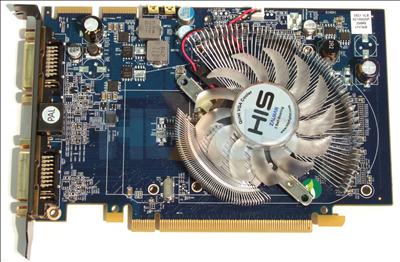HD 2600 XT Zalman appearance
Both the HIS cards we are looking at here deviate from the reference design.
First up is the HD 2600 XT Zalman which, unsurprisingly, features a Zalman-designed cooling solution - the VF100-Al.
This is an all-aluminium design that sits towards the bottom of Zalman's range of graphics-card coolers. It has an asymmetrical fin design to maximise the surface area without interfering with the mainboard.
These fins are cooled by a 70mm fan and that helps keep the noise level considerably lower than that of the reference Radeon HD 2600 XT cooler.
As with the reference cooler, the Zalman VF100-Al also allows the card to maintain a single-slot design. Ideal for those who find themselves short on space but still need a low-noise solution.
Unlike the reference cooler, however, the Zalman doesn't make contact with the cards RAM and there are no separate RAM sinks fitted. This means that the only cooling for the memory chips is air that has already been heated by the fins.
While it proves a quiet solution, the overall cooling performance of the Zalman VF100-Al is somewhat lacking. Idle temperature of 70C, rising to 80C under full load, is not what we'd hope for from a mid-range part.
This poor cooling performance is one reason why the HIS Radeon HD 2600 XT Zalman Fan GDDR3 comes clocked at the stock speed for GDDR3-based HD 2600 XTs - 800MHz on the core and 1400MHz for the memory.
The PCB itself is also considerably shorter than that of the HD 2600 XT reference board. It appears to be based around a similar, but not quite identical, design to the HD 2600 Pro - as used on the Sapphire Radeon HD 2600 Pro we looked at previously.
With just 256MiB of GDDR3, all four memory chips are fitted to the front of the card. HIS also produces a 512MiB version of this board and that uses the silk-screened connectors we can see here.
Internal CrossFire connectors are present to allow for hardware CrossFire operation.
As with the HD 2600 XT reference board, and unlike the GeForce 8600 GTS, HIS has not included a PEG power connector.
Our testing suggests that this is a case of NVIDIA either being cautious, or accommodating some extra overclocking headroom, rather than the HD 2600 XT having lower power consumption.
On the backpanel we find a pair of HDCP-protected, dual-link DVI-I connectors, along with a VIVO mini-DIN socket.
HIS has chosen to gold-plate the DVI ports, a strategy that was initially called the "Hi-fi" concept. So if you've found your current cards image quality - or bling - lacking, then HIS may just have the card for you. To us, though, it just looks like another marketing-led 'feature' with little technical merit.













